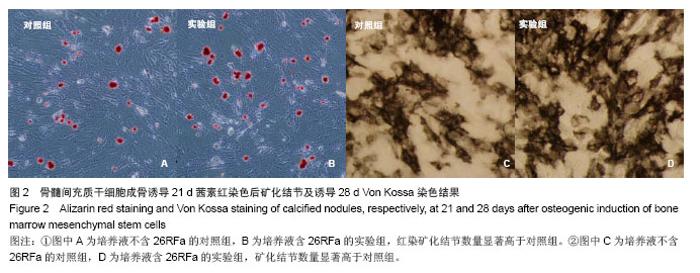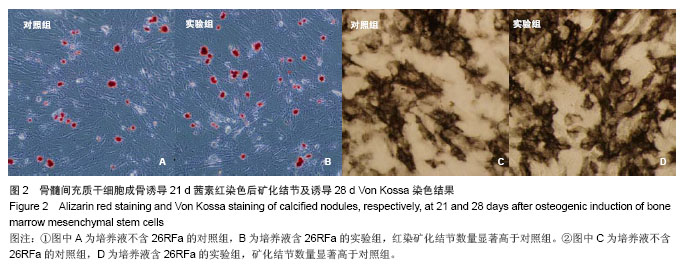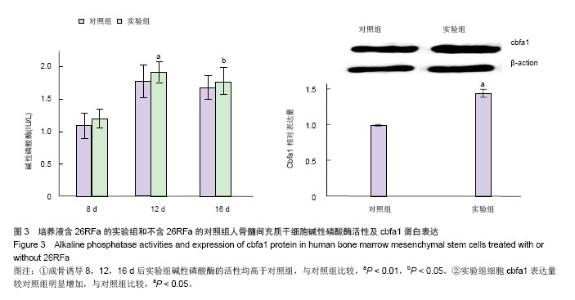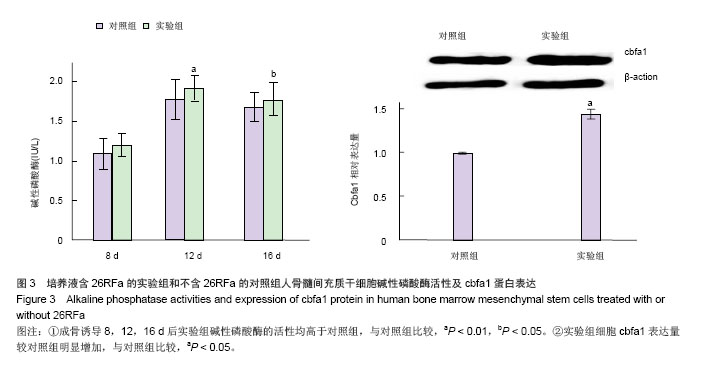Chinese Journal of Tissue Engineering Research ›› 2014, Vol. 18 ›› Issue (10): 1508-1513.doi: 10.3969/j.issn.2095-4344.2014.10.006
Previous Articles Next Articles
26RFa effects on osteogenic differentiation of human bone marrow mesenchymal stem cells
Du Bin1, Lin Qing1, Liu Meng-jun1, Chen Zhi-xin2
- 1 First Clinical Medical College of Lanzhou University, Lanzhou 730000, Gansu Province, China; 2 First Department of Orthopedics, Gansu Provincial Hospital, Lanzhou 730000, Gansu Province, China
-
Online:2014-03-05Published:2014-03-05 -
Contact:Chen Zhi-xin, M.D., Chief physician, First Department of Orthopedics, Gansu Provincial Hospital, Lanzhou 730000, Gansu Province, China -
About author:Du Bin, Master, First Clinical Medical College of Lanzhou University, Lanzhou 730000, Gansu Province, China
CLC Number:
Cite this article
Du Bin, Lin Qing, Liu Meng-jun, Chen Zhi-xin. 26RFa effects on osteogenic differentiation of human bone marrow mesenchymal stem cells [J]. Chinese Journal of Tissue Engineering Research, 2014, 18(10): 1508-1513.
share this article
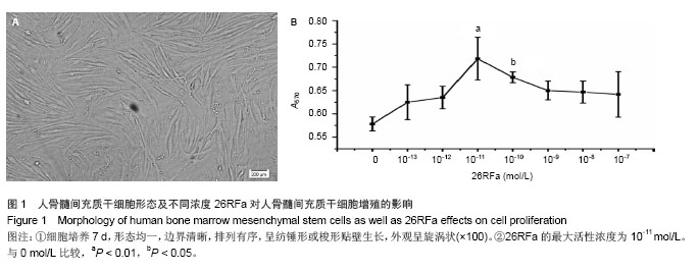
2.1 人骨髓间充质干细胞形态学观察结果 人骨髓间充质干细胞分布均匀,形态均一,边界清晰,排列有序,呈纺锤形或梭形贴壁生长,外观呈旋涡状(图1A)。 2.2 MTT法测26RFa的最大活性浓度 比较不同浓度的26RFa对应的A值可以看出,26RFa浓度为10-11 mol/L、10-10 mol/L两组分别与对照组相比,差异有显著性意义 (P < 0.01,P < 0.05,图1B)。从图1B可以看出,当26RFa 浓度小于10-11 mol/L时,其对人骨髓间充质干细胞的增殖作用随浓度的增大而增大,而26RFa浓度大于10-11 mol/L时,其对人骨髓间充质干细胞的增殖作用随浓度的增大而减小,因此26RFa的最大活性浓度为10-11 mol/L(P < 0.01)。"
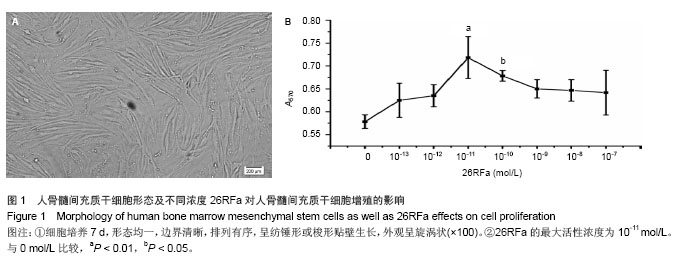
| [1]Erices A,Conget P,Minguell JJ.Mesenchymal progenitor cell in human umbilical cord blood.Br J Haematol.2000;109(1): 235-242.[2]Bassett CA, Pilla AA, Pawluk RJ.A non-operative salvage of surgically-resisitant pseudarthroses and non-unions by pulsing electromagnetic fields. A preliminary report Clin Orthop Relat Res. 1977;(124):128-143.[3]Basset CA, pawlik RJ, Pilla AA.Augmentation of bone repair by inductively coupled electromagnetic fields. Science. 1974; 184(4136):575-577.[4]Gulotta LV, Kovacevic D, Packer JD, et al. Bone Marrow-Derived Mesenchymal Stem Cells Transduced With Scleraxis Improve Rotator Cuff Healing in a Rat Model. Am J Sports Med. 2011 Feb 18.[5]Javazon EH, Colter DC, Schwarz EJ, et al. Rat marrow stromal cells are more sensitive to plating density and expand more rapidly from single-cell-derived colonies than human marrow stromal cells. Stem Cells. 2001;19(3):219-225.[6]Minguell JJ,Erices A,Congetp.Mesenchymal stem Cell.Exp Biol Med.2001;226(6):507-526.[7]Trivedi HL,Vanilar AV,Thakker U,et al.Human Adipose Tissue-derived Mesenchymal Stem Cells Combined with Hematopoietic Stem Cell Transplation Synthesize Insulin. Transplat Proc.2008;40(4):1135-1139.[8]Yagi K,Kojima M,Oyagi S,et al.Application of Mesenchmal Stem Cell to Liver Regenerative Medicine. Yakugaku Zasshi. 2008;128(1):3-9. [9]Sato K,Ozaki K,OH I,et,al.Nitric Oxide Plays a Critical Role in Suppression of T-cell Proliferation by Mesenchymal Stem Cell. Blood. 2007;109(1):228-234.[10]Blazra BR,Taylor PA.Regulatiory T cells.Biol Blood Marrow Transplant.2005;11(2Sup12):46-49.[11]Tang J, Wang J, Guo L,et al.Mesenchymal stem cells modified with stromal cell-derived factor 1 alpha improve cardiac remodeling via paracrine activation of hepatocyte growth factor in a rat model of myocardial infarction.Mol Cells.2010;29(1):9-19.[12]Jeong WK, Park SW, Im GI. Growth factors reduce the suppression of proliferation and osteogenic ifferentiation by titanium particles on MSCs.J Biomed Mater Res A. 2008; 86(4):1137-1144.[13]Ebra S,Nadayama K. Mechanism for the action of bone morphogenetic proteins and regulation of their activity. Spine.2002;27(16 suppl 1): 10-15.[14]Bhatia M,Shokui S.Inflammatory Mediators in Acute Pancreatitis.Pathol.J Pathol.2000;190(2):117-125. [15]刘震,程若川,方向,等. PAAF与ASPAAF诱导的肠损伤比较的实验研究[J].中国普外基础与临床杂志,2008,15(8):555-559.[16]Boer HH, Schot LP, Veenstra JA, et al. Immunocytochemical identification of neural elements in the central nervous systems of a snail, some insects, a fish, and a mammal with an antiserum to the molluscan cardio-excitatory tetrapeptide FMRF-amide. Cell Tissue Res.1980;213(1): 21-27.[17]Bock J,Liebisch G,Schweimer J,et al.Exogenous Sphingo2 Myelinase Causes Impaired Intestinal Epithelial Barrier Function. World Gastroenterol.2007;13(39):5217-5225.[18]Zhang XP,Chen L,Hu QF,et al.Effects of Large Dose of Dexamethasone on Inflammatory Mediators and Pancreatic Cell Apoptosis of Rats with Severe Acute Pancreatitis. World J Gastroenterol. 2007;13(41):5506-5511[19]Tsutsui K, Bentley GE, Kriegsfeld LJ,et al. Vaudry Discovery and evolutionary history of gonadotrophin-inhibitory hormone and kisspeptin: new key neuropeptides controlling reproduction. J Neuroendocrinol. 2010;22(7):716-727.[20]Chartrel N, Dujardin C, Leprince J,et al. Isolation, characterization, and distribution of a novel neuropeptide, Rana RFamide (R-RFa), in the brain of the European green frog Rana esculenta. J Comp Neurol. 2002;448(2):111-127. [21]Takayasu S, Sakurai T, Teranishi H ,et al.A neuropeptide ligand of the G protein-coupled receptor GPR103 regulates feeding,behavior arousal,and blood pressure in mice. Proc Natl Acad Sci U S A. 2006;103(19):7438-7443.[22]Linacre A, Kellett E, Saunders S, et al. Burke Cardioactive neuropeptide Phe-Met-Arg-Phe-NH2 (FMRFamide) and novel related peptides are encoded in multiple copies by a single gene in the snail Lymnaea stagnalis.J Neurosci. 1990;10(2): 412-419.[23]Fukusumi S, Yoshida H, Fujii R, et al. A new peptidic ligand and its receptor regulating adremal fuction in rats. J Biol Chem. 2003;278(47):46387-46395. [24]Tobari Y, Iijima N, Tsunekawa K, et al.Identification, localisation and functional implication of 26RFa orthologue peptide in the brain of zebra finch (Taeniopygia guttata). J Neuroendocrinol. 2011;23(9):791-803.[25]Liu Y, Zhang Y, Li S, et al. Molecular cloning and functional characterization of the first non-mammalian 26RFa/QRFP orthologue in Goldfish, Carassius auratus. Mol Cell Endocrinol. 2009;303(1-2):82-90. [26]Yang HY, Tang J, Iadarola M, et al. Are Phe-Met-Arg-Phe-NH2 immunoreactive peptides endacoids modulating opiate antinociception? Prog Clin Biol Res. 1985; 192:313-322. [27]Fukusumi S, Habata Y, Yoshida H,et al. Characteristics and distribution of endogenous RFamide-related peptide-1. Biochim Biophys Acta. 2001;1540(3):221-232. [28]Chartrel N, Alonzeau J, Alexandre D, et al. Llorens-Cortes The RFamide neuropeptide 26RFa and its role in the control of neuroendocrine functions Front. Front Neuroendocrinol. 2011;32(4):387-397.[29]Baribault H, Danao J, Gupte J, et al.The G-protein-coupled receptor GPR103 regulates bone formation. Mol Cell Biol. 2006;26(2):709-717.[30]Ohtaki T, Shintani Y, Honda S,et al. Metastasis suppressor gene KiSS-1 encodes peptide ligand of a G-protein-coupled receptor.Nature.2001;411(6837): 613-617.[31]Bruzzone F, Lectez B, Alexandre D,et al. Distribution of 26RFa binding sites and GPR103 mRNA in the central nervous system of the rat. J Comp Neurol. 2007;503(4): 573-591. [32]Zhang Q, Qiu P, Arreaza MG, et al. P518/Qrfp sequence polymorphisms in SAMP6 osteopenic mouse. Genomics. 2007; 90(5):629-35[33]王琳琳,董为人,朱衍菲,等.脂肪源性干细胞向心肌细胞分化及其移植治疗心血管疾病[J].中国组织工程研究与临床康复,2011, 15(14):2648-2652.[34]Nakamichi I, Toivola DM, Strnad P, et al. Keratin 8 overexpression promotes mouse Mallory body formation. J Cell Biol. 2005;171(6):931-937.[35]Ukena K, Tachibana T, Iwakoshi-Ukena E,et al. Identification, localization, and function of a novel avian hypothalamic neuropeptide, 26RFa, and its cognate receptor, G protein-coupled receptor-103. Endocrinology. 2010;151(5): 2255-2264.[36]Casado-Díaz A, Santiago-Mora R, Jiménez R,et al. Cryopreserved human bone marrow mononuclear cells as a source of mesenchymal stromal cells: application in osteoporosis research. Cytotherapy. 2008;10(5):460-468.[37]Matsumoto T,Kuroda R,Mifune Y,et al.Circulating endothelial/skeletal progenitor cells for bone regeneration and healing. Bone.2008;43(3):434-439.[38]Lippens E, Cornelissen M.Slow Cooling Cryopreservation of Cell-Microcarrier Constructs. Cells Tissues Organs. 2010. [Epub ahead of print] [39]Zajac JM, Mollereau C.RFamide peptides.Introduction. Peptides. 2006; 27(5):941-942.[40]Bechtold DA, Luckman SM. The role of RFamide peptides in feeding. J Endocrinol. 2007;192(1):3-15.[41]Jiang Y, Luo L, Gustafson EL, et al.Identification and characterization of a novel RF-amide pepfide ligand for orphan G-protein-coupled receptor SP9155. J Biol Chem. 2003;278(30):27652-27657.[42]Mulumba M, Jossart C, Granata R, et al. GPR103b functions in the peripheral regulation of adipogenesis. Mol Endocrinol. 2010 ;24(8):1615-1625. [43]Chartrel N, Dujardin C, Anouar Y,et al. Identification of 26RFa, a hypothalamic neuropeptide of the RFamide peptide family with orexigenic activity. Proc Natl Acad Sci U S A.2003; 100(25): 15247-15252.[44]Bruzzone F, Lectez B, Tollemer H,et al.Anatomical distribution and biochemical characterization of the novel RFamide peptide 26RFa in the human hypothalamus and spinal cord.J Neurochem. 2006;99(2):616-627. |
| [1] | Lin Qingfan, Xie Yixin, Chen Wanqing, Ye Zhenzhong, Chen Youfang. Human placenta-derived mesenchymal stem cell conditioned medium can upregulate BeWo cell viability and zonula occludens expression under hypoxia [J]. Chinese Journal of Tissue Engineering Research, 2021, 25(在线): 4970-4975. |
| [2] | Pu Rui, Chen Ziyang, Yuan Lingyan. Characteristics and effects of exosomes from different cell sources in cardioprotection [J]. Chinese Journal of Tissue Engineering Research, 2021, 25(在线): 1-. |
| [3] | Zhang Xiumei, Zhai Yunkai, Zhao Jie, Zhao Meng. Research hotspots of organoid models in recent 10 years: a search in domestic and foreign databases [J]. Chinese Journal of Tissue Engineering Research, 2021, 25(8): 1249-1255. |
| [4] | Hou Jingying, Yu Menglei, Guo Tianzhu, Long Huibao, Wu Hao. Hypoxia preconditioning promotes bone marrow mesenchymal stem cells survival and vascularization through the activation of HIF-1α/MALAT1/VEGFA pathway [J]. Chinese Journal of Tissue Engineering Research, 2021, 25(7): 985-990. |
| [5] | Shi Yangyang, Qin Yingfei, Wu Fuling, He Xiao, Zhang Xuejing. Pretreatment of placental mesenchymal stem cells to prevent bronchiolitis in mice [J]. Chinese Journal of Tissue Engineering Research, 2021, 25(7): 991-995. |
| [6] | Liang Xueqi, Guo Lijiao, Chen Hejie, Wu Jie, Sun Yaqi, Xing Zhikun, Zou Hailiang, Chen Xueling, Wu Xiangwei. Alveolar echinococcosis protoscolices inhibits the differentiation of bone marrow mesenchymal stem cells into fibroblasts [J]. Chinese Journal of Tissue Engineering Research, 2021, 25(7): 996-1001. |
| [7] | Fan Quanbao, Luo Huina, Wang Bingyun, Chen Shengfeng, Cui Lianxu, Jiang Wenkang, Zhao Mingming, Wang Jingjing, Luo Dongzhang, Chen Zhisheng, Bai Yinshan, Liu Canying, Zhang Hui. Biological characteristics of canine adipose-derived mesenchymal stem cells cultured in hypoxia [J]. Chinese Journal of Tissue Engineering Research, 2021, 25(7): 1002-1007. |
| [8] | Geng Yao, Yin Zhiliang, Li Xingping, Xiao Dongqin, Hou Weiguang. Role of hsa-miRNA-223-3p in regulating osteogenic differentiation of human bone marrow mesenchymal stem cells [J]. Chinese Journal of Tissue Engineering Research, 2021, 25(7): 1008-1013. |
| [9] | Lun Zhigang, Jin Jing, Wang Tianyan, Li Aimin. Effect of peroxiredoxin 6 on proliferation and differentiation of bone marrow mesenchymal stem cells into neural lineage in vitro [J]. Chinese Journal of Tissue Engineering Research, 2021, 25(7): 1014-1018. |
| [10] | Zhu Xuefen, Huang Cheng, Ding Jian, Dai Yongping, Liu Yuanbing, Le Lixiang, Wang Liangliang, Yang Jiandong. Mechanism of bone marrow mesenchymal stem cells differentiation into functional neurons induced by glial cell line derived neurotrophic factor [J]. Chinese Journal of Tissue Engineering Research, 2021, 25(7): 1019-1025. |
| [11] | Duan Liyun, Cao Xiaocang. Human placenta mesenchymal stem cells-derived extracellular vesicles regulate collagen deposition in intestinal mucosa of mice with colitis [J]. Chinese Journal of Tissue Engineering Research, 2021, 25(7): 1026-1031. |
| [12] | Pei Lili, Sun Guicai, Wang Di. Salvianolic acid B inhibits oxidative damage of bone marrow mesenchymal stem cells and promotes differentiation into cardiomyocytes [J]. Chinese Journal of Tissue Engineering Research, 2021, 25(7): 1032-1036. |
| [13] | Guan Qian, Luan Zuo, Ye Dou, Yang Yinxiang, Wang Zhaoyan, Wang Qian, Yao Ruiqin. Morphological changes in human oligodendrocyte progenitor cells during passage [J]. Chinese Journal of Tissue Engineering Research, 2021, 25(7): 1045-1049. |
| [14] | Wang Zhengdong, Huang Na, Chen Jingxian, Zheng Zuobing, Hu Xinyu, Li Mei, Su Xiao, Su Xuesen, Yan Nan. Inhibitory effects of sodium butyrate on microglial activation and expression of inflammatory factors induced by fluorosis [J]. Chinese Journal of Tissue Engineering Research, 2021, 25(7): 1075-1080. |
| [15] | Wang Xianyao, Guan Yalin, Liu Zhongshan. Strategies for improving the therapeutic efficacy of mesenchymal stem cells in the treatment of nonhealing wounds [J]. Chinese Journal of Tissue Engineering Research, 2021, 25(7): 1081-1087. |
| Viewed | ||||||
|
Full text |
|
|||||
|
Abstract |
|
|||||
